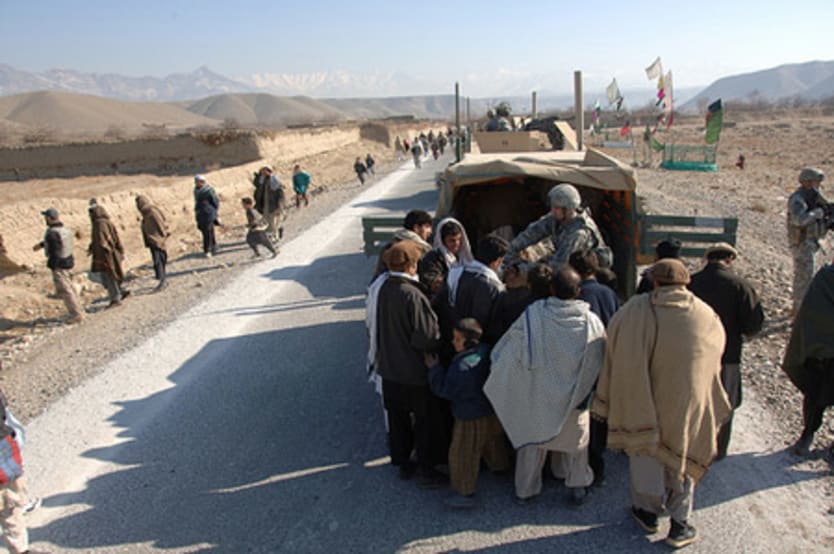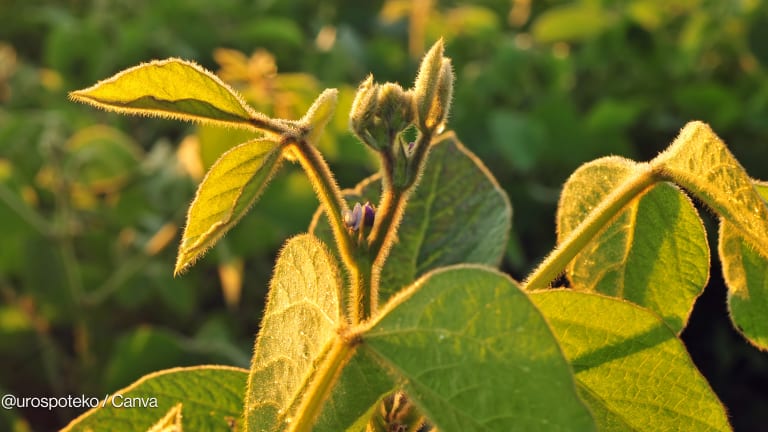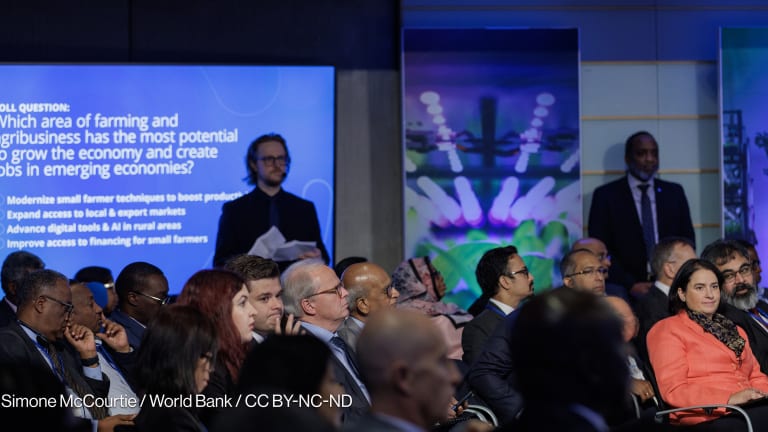
David Belgrove has come to several realizations in the past few months, but one stands out.
“Eradication alone is not going to solve this,” the U.K. government’s head of counternarcotics in Afghanistan said. “Eradication is just one tool, and quite a small tool, in the overall strategy. More people have realized that in the past year.”
In response to Afghanistan’s explosive growth in poppy production, many in the international community had in the past few years pushed for widespread eradication. More recently, the panacea became improved security, then finally political will.
“None of these on its own is going to actually solve the problem,” Belgrove said during an interview with Devex in his office inside the heavily fortified compound of the British embassy here. “It’ll be this slow process of improving infrastructure and building markets that will solve the problem because that’s what gives farmers access to other livelihoods.”
For more than three years, Belgrove has been at the forefront of the international effort to stanch the flow of poppies, the raw material for opium and heroin. He made little headway until this year, when production decreased considerably across the north. The news was much needed, as the Taliban have been growing bolder, and the situation across Afghanistan growing more dire throughout 2008.
“Frankly, we are running out of time,” Adm. Mike Mullen, chairman of the U.S. Joint Chiefs of Staff, said in September of the war in Afghanistan. “We have to counter the opium trade by supporting alternative livelihoods for Afghan farmers, and we must call on more support from friends and allies, and better coordination under a strong international coordinator.”
In an all-out push to wean the south off poppy and turn the tide in Afghanistan, the U.K., U.S. and Afghan governments have taken the lessons learned this past year to craft a comprehensive and better coordinated counternarcotics strategy.
Trouble in the south
Since the fall of the Taliban, poppy production in Afghanistan has soared from 3,500 metric tons in 2002 to 8,200 metric tons - 93 percent of the world’s supply - five years later. Most observers agree that the hydra-headed anti-poppy efforts of Kabul and the international community were to blame: In the early years, the U.K. government, working with Kabul, paid farmers to eradicate poppy. Afghan officials pocketed the money, and the number of poppy farmers grew. In 2005, the United States, grasping the threat, outlined plans that hinged on aerial eradication, but Afghanistan and the international community balked.
With the United Nations and NATO playing backup, counternarcotics in Afghanistan became a dance of expansive bureaucracies attempting - and mostly failing - to weave together their various departments, programs, agendas and voices. But in 2008, even as Afghanistan became more deadly than Iraq for international forces, poppy-growing acreage fell 19 percent, according to an annual report released in late August by the U.N. Office on Drugs and Crime. Poppy-free provinces rose from 13 to 18 - more than half the country.
Still, overall production dropped a mere 6 percent, and nearly all the poppy cultivation was restricted to seven provinces in the country’s south and west, where Taliban insurgents are most active. The nexus is Helmand, which, though only the size of Wales, now produces more than 60 percent of the world’s supply of poppy. It’s also a Taliban hotbed.
“It’s very clear why there’s insecurity in Helmand and the south: Insurgency and poppy cultivation are connected,” said Waliullah Rahmani, founding director of the Kabul Center for Strategic Studies. “Poppy in the south is one of the main sources fueling the insurgency.”
Which is precisely why eradication efforts have fallen short.
“The main problem was the security,” said Merajuddin Hatami, a 28-year-old Kabuli who worked as an interpreter on a spring 2008 eradication program in Helmand for DynCorp International, a U.S.-based security firm hired regularly by the the departments of State and Defense. “When Taliban shot at us, we would just leave. The government has to be in control, but it wasn’t.”
The project ultimately eradicated poppies in 1 percent of Helmand’s poppy fields.
“They did come under attack and they did have to leave,” Belgrove said. “We’ve been keen to stress to the government of Afghanistan that if eradication is going to be done effectively, then they need to actually supply force protection by the Afghan National Army to cordon the area.”
Many believe the presence of the increasingly well-trained and effective ANA in spring 2009 eradication efforts will make a difference. In addition, NATO’s British contingent in Helmand will soon expand from 8,000 troops to 12,000, and NATO recently gained Afghan President Hamid Karzai’s approval to destroy drug labs and chase and arrest traffickers.
For the moment, the intense insurgency in Helmand creates a vicious cycle: Because of the insecurity, law enforcement and eradication efforts are ineffective, which leads to more poppy farming and a stronger insurgency.
“In Helmand, the poppy industry is an economy,” said Cristy Ututalum, senior livelihoods adviser to Afghanistan’s Ministry of Agriculture and Livestock. “When the poppy man comes, he gives me seeds, he gives me cash, technical advice, and then he picks up the goods - it’s an entire market.”
The pull of the poppy
Despite a recent drop in opium prices, farmers make up to four times more money growing poppy than other local staples such as grapes, pomegranates or cotton. Further, Afghanistan’s agricultural infrastructure has been devastated - irrigation canals, roads, entire markets and value chains have been ravaged since the Soviets arrived in the late ’70s. In a country where nearly 80 percent of livelihoods are directly linked to agriculture, such problems have left many acutely desperate.
“As long as there is this entrenched mafia and a market and the fact that Afghanistan has a certain amount of wheeling and dealing from official sources,” said Ututalum, “poppy will remain a problem.”
That wheeling and dealing goes right to the top. In 2007, a study by a leading Afghan think tank linked 17 members of parliament to the drug trade. New York Times reporter Carlotta Gall and Thomas Schweich, former senior U.S. counternarcotics official in Afghanistan, have argued that Karzai has protected many big-time smugglers, including his brother, Ahmed Wali, who has for years been linked to the drug trade.
And this past summer, Abdullah Laghmani, deputy director of Afghanistan’s National Directorate of Security, said parliamentarians were involved in the drug trade and linked to the Taliban. Laghmani neither named names nor offered proof, but his accusations, like similar ones in the past, were met with more nodding than outrage.
Corruption is a part of everyday life in Afghanistan; a recent U.N. report found that the average Afghan hands over about $100 per year in bribes, or about 20 percent the average non-poppy income. A harsh crackdown on corruption is necessary, but, like eradication, it will not be a silver bullet for the drug trade.
Improved security, political will and a dash of livelihoods
From 2002 to fall 2008, the United States and United Kingdom spent about $1.3 billion and more than $500 million on counternarcotics, respectively. The duo have committed an additional $2 billion over the next four years to support the government of Afghanistan’s eight-pillar counternarcotics strategy, which involves interdiction, an improved justice system, eradication, and greater alternative livelihoods. Toward that last goal, the U.S. Agency for International Development and the U.K. Department for International Development are implementing a variety of projects totaling $850 million.
Fortunately, a handful of Afghanistan’s provincial governors may soon be able to pitch in.
“The governors played an important role in this year’s poppy reduction,” said Rahmani, highlighting Balkh Gov. Atta Mohammed Noor for showing political leadership to crack down on poppy. “If such governors are put in place in other provinces, if there is good leadership, if the people are not corrupt, the situation will improve.”
This is an idea the international community is beginning to fully appreciate. One successful project in the north and east has been the Good Performance Initiative, which rewards governors who reduce poppy output with funding for development projects. Sponsored by the United States and United Kingdom but operated by the Afghan counternarcotics ministry, the fund was created in 2005 but had little impact until 2007. To date, the Badakshan province has earned $2 million, while the Nangarhar province has won $10 million, which the governor is using to improve agricultural infrastructure. Both cut production to zero this year, as did Balkh.
Belgrove and the United States are working with Kabul to bring the good performance program to the south.
“There’s been more acknowledgment that this has to be a provincial, even a district-led process,” Belgrove said. “Governors have a very important role to play, and we need to give them the capacity to do it. We’re so far very pleased with the efforts of Gov. Mangal in Helmand.”
Gov. Gulab Mangal, in office since March, recently began a comprehensive initiative to persuade thousands of farmers to drop poppy for licit crops. He’s backed by $8 million from DFID and USAID, along with help from a U.K.-led provincial reconstruction team and the Afghan Ministry of Counternarcotics.
The scheme began in late summer, just before the October planting season, with an information campaign intended to increase awareness of the illegality of poppy and the government’s threat to eradicate it. Simultaneously, Mangal plans to offer more than 25,000 farmers the fertilizer and seeds needed to culvitate high-value alternatives. The next step is a well-armed task force that will establish security within small areas of Helmand, to provide freedom of movement for DFID and USAID contractors to deliver high-quality seed, fertilizer and technical expertise for wheat crops.
“We’re sponsoring the governor, but it’s very much his initiative,” said Belgrove, adding that wheat distributors have been brought in and the World Food Program has agreed to purchase any surplus crops. “Meanwhile, if you still grow poppy you stand a very high chance of having it eradicated next year.”
Rebuilding markets, providing real alternatives
In the 1960s, USAID hired Morrison-Knudsen Corp., the company that built the Hoover Dam, to build a dam and 300 miles of irrigation canals across the Helmand Valley. The successful project created 250,000 arable acres, which became one of the most fertile regions of Afghanistan, and placed hundreds of Americans in the provincial capital, Lashkar Gah.
That infrastructure was destroyed by the Soviets and the war years that followed. Now dozens of livelihoods projects are attempting to rebuild and improve upon those markets. In the Counter-Part Program, USAID and DFID pay 85 percent of the costs for wheat inputs, while farmers pay 15 percent. In another project, USAID is working with local elders to distribute 288 metric tons of corn seed and 1,400 metric tons of fertilizer to 5,000 Helmand farmers this year. The idea is to establish markets via contract farming, in which buyers are linked to farmers, who only grow as much as buyers request.
“We call it contract farming because we’re facilitating a contract,” said Loren Owen Stoddard, director of alternative livelihoods for USAID in Afghanistan. “There’s not a guaranteed price, but there’s a guaranteed market.”
Ututalam has been working with southern governors to determine which alternative crops are most suitable for each district. Along with cotton, she sees almonds, walnuts and pistachios elbowing into poppy territory in the coming years.
For many, poppy farming is unappealing. It’s so labor intensive - requiring near-constant weeding and then scoring at harvest time - that women and children are often put to work in the fields. The drugs made from poppy are haram, or forbidden, in Islam. Finally, growing poppy is illegal in Afghanistan.
“If you ask the farmer, he doesn’t want to plant poppy,” said Ututalam. “He just needs the proper infrastructure and support system - you’ve got to create and sustain that market.”
Information about USAID and other livelihoods programs is spread via agricultural fairs. Stoddard is working to bring successful agricultural infrastructure projects from the country’s north to the south, building and repairing 700 kilometers of road and nearly 3,300 kilometers of irrigation and drainage canals, for instance. Despite a turnout of 3,000 at an August agricultural fair, progress has been limited.
“Security continues to be the biggest challenge in Helmand,” admitted Stoddard. “Where there is more security, there will be more legitimate trade.”
To avoid Helmand’s insecure roads, USAID and the Afghan government recently broke ground on a combination airport and agriculture center in Lashkar Gah, the Helmand capital. The agriculture center will consolidate exports to be flown to Kabul and regional trade centers such as Karachi and Dubai.
New York-based aid group Mercy Corps also works within and near poppy-growing regions in Kandahar and Helmand, providing farmers with certified crop seeds and veterinary medicine for livestock.
“If somebody at some stage gets the balls to really put the hammer down and stop people growing poppy,” said Country Director Nigel Pont, “we hope the communities we work with by that stage have enough opportunities to do other things.”
An uphill climb
In early October, the Taliban pledged to fiercely defend their poppy turf, but Belgrove believes the hammer is falling with his and Mangal’s new strategy: information and improved security plus alternative inputs and a market followed up with law enforcement. It will mean persuading farmers to turn away from more profitable crops and establishing a rule of law no Helmand governor has been able to achieve.
“If it works, it’s a model we want to build on,” said Belgrove, who envisions a 10- or even 20-year struggle. “I would say we are at the turning point. What we cannot afford to be at the moment is complacent. The progress we’ve made is very fragile, and we need to work to consolidate gains in the north and center, and in the south, try and actually turn the tide.”
As fall planting season arrives and a harsh winter food shortage looms, farmers in the desolate, insecure south will have to decide: Should I listen to the government or the opium mafia? Put another way: Who offers greater security?
The answers will come next spring, when the poppies bloom.








